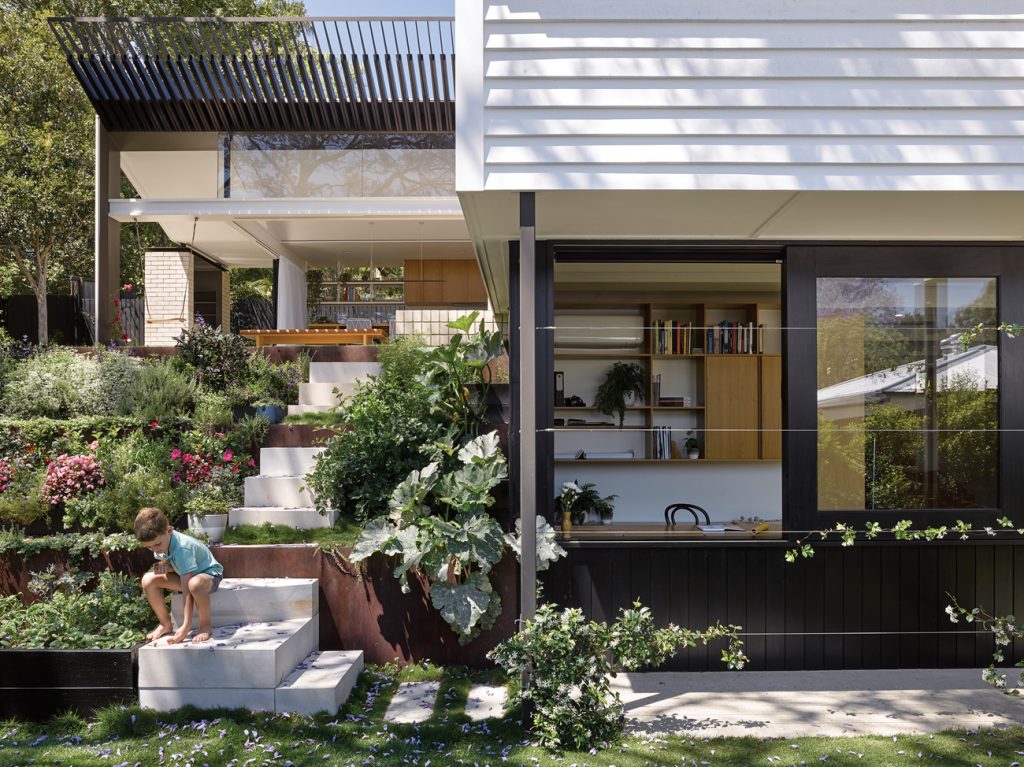Changing the Scenery
A bountiful Brisbane garden entices architect Scott Petherick and family to fully embrace an alfresco lifestyle.
In the inner suburb of Paddington, Brisbane, a subtropical, domestic landscape engulfs gully and hillside. Slender palms push through mango tree canopies while poincianas extend elegant limbs with scarlet blossoms. In the backyard of this 1920s weatherboard home, a magnificent jacaranda tree casts dappled shade across the north-east corner of the garden, blanketing lawn with lavender blooms each spring.
It’s the home of architect, Scott Petherick, his wife Emma and children Jacob and Eleanor, who settled here recently from Melbourne. Their move north coincided with Scott establishing his practice, SP Studio, and the family embracing a subtropical way of life, where living is encouraged in the balmy outdoors.
As a means to transition the historic Queenslander to a contemporary home engaged with the garden, Scott proposed a series of built and landscape interventions. Small edits were made inside, but the big moves were reserved for the backyard where a kitchen pavilion and companion garden were introduced. The pavilion extends to level with the backyard, just a few steps down from the timber floors of the house proper. It shelters both kitchen and dining room below a feathered canopy and opens fully on two sides via large sliding doors.
Inside, the program is intensified and gathering is formalised around table and chairs, but as the concrete slab folds down onto blonde brick pavers, a patio and fireplace form a casual auditorium around which all are encouraged to gather more loosely beneath open skies.
Commanding the lower, northern side of the backyard, the magnificent jacaranda tree offers a spatial counterpoint to the kitchen pavilion on the higher southern side. The jacaranda is considered a room in its own right – a kind of greenhouse – a place where the subtropical climate of Brisbane becomes a little less equatorial. Beneath its sprawling limbs, the northern sun is tempered and a cooler micro-climate is fostered. Deciduous varieties are encouraged and delicate species of herbs and flowers flourish, a condition which delights and surprises the Petherick family who are still adjusting to the warmer temperatures here.
Between the elevated kitchen terrace and the sunken jacaranda, a stepped garden tames the extreme slope. Three concrete block walls do the heavy retaining while blackbutt timber sleepers form the edges to long garden beds running east–west. Bringing a rusted patina and providing the backdrop for delicate creeping fig, weathered corten steel is sleeved over the top of block walls. Large sandstone steps traverse the fall of around two and a half metres, bridging upper and lower terraces and enabling pebbled floor access to each row of plants. Thyme, rosemary and parsley bring the herbaceous notes to garden staples like tomatoes, lettuces, chillies and snap peas while a healthy scattering of blossoms engage small fingers in seasonal plucking and delight the eye with their vibrant colour.
What is clever about the design of both built and natural elements is the variety of spatial conditions that have resulted. Each territory including kitchen pavilion, fireplace patio, stepped garden and jacaranda terrace takes best advantage of the existing terrain and plant life. Within a small footprint area, countless ways are offered to young and old to engage with the outdoors. A carefully edited material palette, celebrating the contrasts inherent in masonry versus timber and hard versus soft landscaping, brings a tactility and richness to each masterfully conceived space.
“We really wanted to exploit the material language to define indoor and outdoor territories,” Scott says. “Heavy elements such as the concrete slab and brick tie into the landscape and the lighter timber elements tie back to the original house.” One of the most surprising outcomes of the project for Scott was the delight he encountered through the process of personally constructing the stepped garden. “After building it I discovered I’m a gardener at heart,” Scott says. “Until now we’ve never had the opportunity to experiment with gardening but we like the quiet it promotes. There is a real sense of calm and sanctuary when we’re out here.”
Scott is humble in accepting praise for creating this glorious garden refuge from what was once an inaccessible and unruly backyard. “That’s what you get with interesting sites,” he says, “interesting outcomes.”










